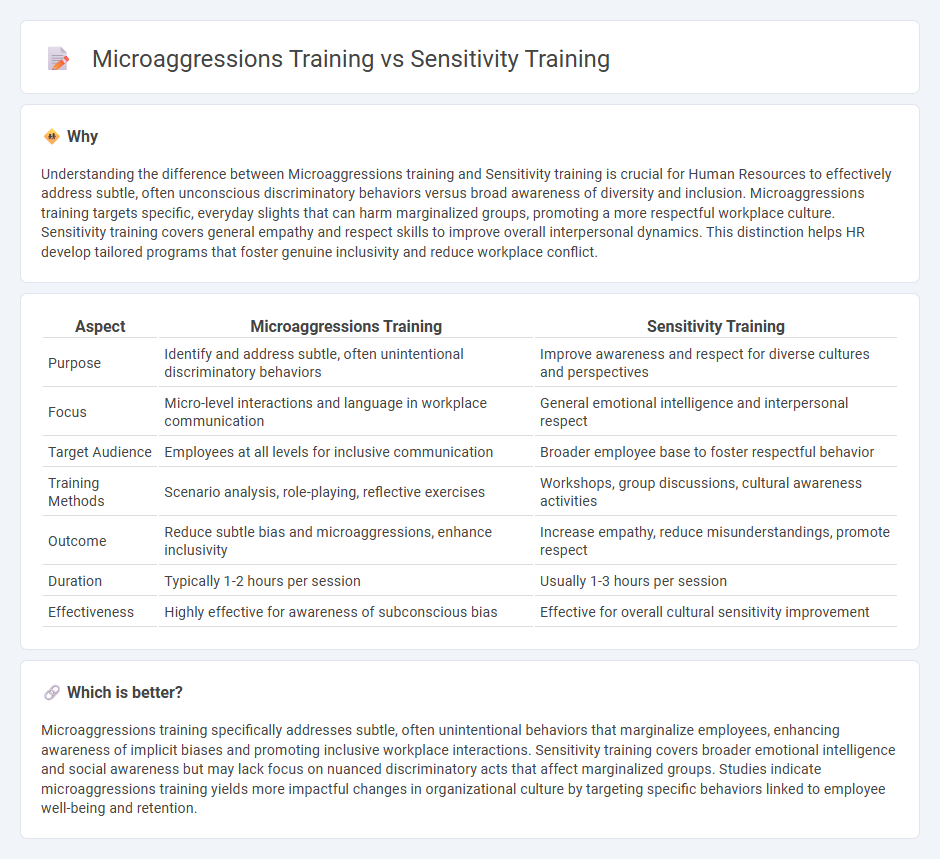
Microaggressions training focuses on identifying and addressing subtle, often unconscious behaviors that negatively impact workplace inclusion and employee well-being. Sensitivity training enhances awareness and empathy by educating employees on cultural differences, communication styles, and respectful interaction. Explore how these targeted training programs can transform your organization's diversity and inclusion efforts.
Why it is important
Understanding the difference between Microaggressions training and Sensitivity training is crucial for Human Resources to effectively address subtle, often unconscious discriminatory behaviors versus broad awareness of diversity and inclusion. Microaggressions training targets specific, everyday slights that can harm marginalized groups, promoting a more respectful workplace culture. Sensitivity training covers general empathy and respect skills to improve overall interpersonal dynamics. This distinction helps HR develop tailored programs that foster genuine inclusivity and reduce workplace conflict.
Comparison Table
| Aspect | Microaggressions Training | Sensitivity Training |
|---|---|---|
| Purpose | Identify and address subtle, often unintentional discriminatory behaviors | Improve awareness and respect for diverse cultures and perspectives |
| Focus | Micro-level interactions and language in workplace communication | General emotional intelligence and interpersonal respect |
| Target Audience | Employees at all levels for inclusive communication | Broader employee base to foster respectful behavior |
| Training Methods | Scenario analysis, role-playing, reflective exercises | Workshops, group discussions, cultural awareness activities |
| Outcome | Reduce subtle bias and microaggressions, enhance inclusivity | Increase empathy, reduce misunderstandings, promote respect |
| Duration | Typically 1-2 hours per session | Usually 1-3 hours per session |
| Effectiveness | Highly effective for awareness of subconscious bias | Effective for overall cultural sensitivity improvement |
Which is better?
Microaggressions training specifically addresses subtle, often unintentional behaviors that marginalize employees, enhancing awareness of implicit biases and promoting inclusive workplace interactions. Sensitivity training covers broader emotional intelligence and social awareness but may lack focus on nuanced discriminatory acts that affect marginalized groups. Studies indicate microaggressions training yields more impactful changes in organizational culture by targeting specific behaviors linked to employee well-being and retention.
Connection
Microaggressions training and sensitivity training are interconnected in Human Resources as both aim to foster inclusive workplace environments by raising awareness of implicit biases and promoting respectful communication. Microaggressions training specifically addresses subtle, often unconscious behaviors that can negatively impact marginalized groups, while sensitivity training broadens this scope by educating employees on cultural competence and empathy. Integrating these trainings helps organizations reduce discrimination, improve employee relations, and enhance overall diversity and inclusion efforts.
Key Terms
Empathy
Sensitivity training emphasizes recognizing others' feelings through awareness of personal biases and respectful communication, fostering empathy by encouraging participants to consider diverse perspectives. Microaggressions training specifically targets subtle, often unconscious slights that can harm marginalized groups, aiming to increase empathy by highlighting the impact of everyday interactions on individuals' well-being. Explore deeper insights into how these trainings cultivate empathy across varied social and professional settings.
Implicit Bias
Sensitivity training aims to enhance awareness and communication by addressing explicit behaviors, while microaggressions training specifically targets subtle, often unconscious slights rooted in implicit bias. Implicit bias influences both formats but is more deeply examined in microaggressions training through identifying and mitigating unintentional discriminatory actions. Explore how understanding implicit bias can transform workplace dynamics and improve inclusivity.
Inclusive Communication
Sensitivity training centers on raising awareness about personal biases to foster respectful interactions, while microaggressions training specifically addresses subtle, often unintentional discriminatory remarks or behaviors that negatively impact marginalized groups. Both approaches emphasize inclusive communication techniques that promote empathy, active listening, and cultural competence in professional and social environments. Explore how these training programs can transform workplace dynamics and contribute to a more inclusive culture.
Source and External Links
Sensitivity Training to Support Workplace Inclusion - Traliant - Sensitivity training raises awareness of employees' attitudes and behaviors toward diverse colleagues, emphasizing clear communication, self-reflection, and ongoing education to foster an inclusive work environment.
Sensitivity training - Wikipedia - Sensitivity training aims to increase self-awareness of personal prejudices and sensitivity to others, originating from Kurt Lewin's group workshops and later expanded by Carl Rogers and others.
What is Sensitivity Training and How to Implement it in the Workplace - This psychological technique uses group discussions to enhance empathy and self-awareness, encouraging honest expression, clarity on behavioral expectations, and continuous learning.
 dowidth.com
dowidth.com